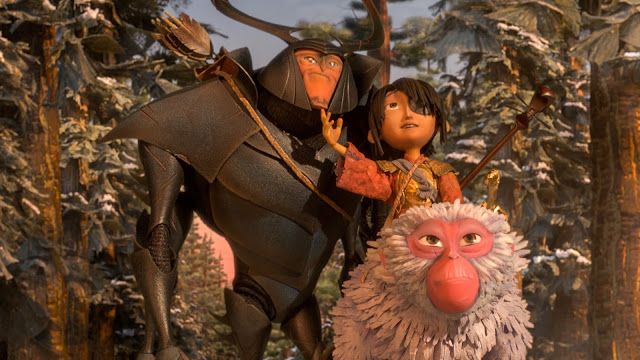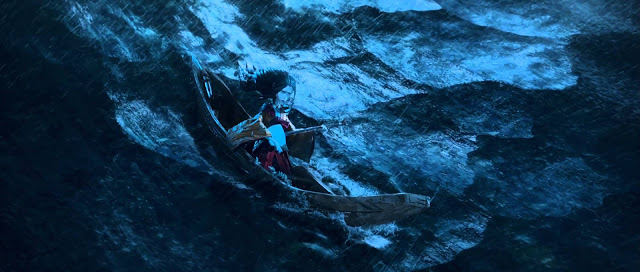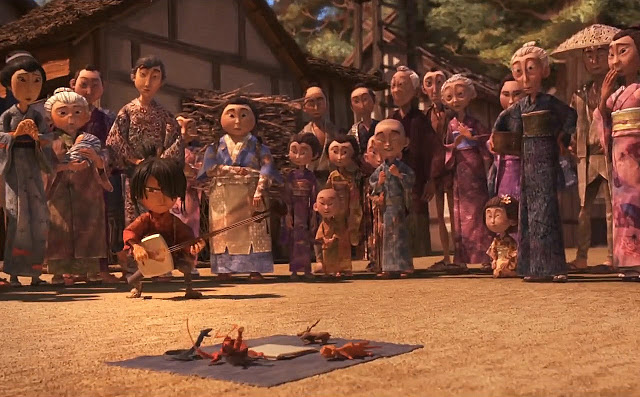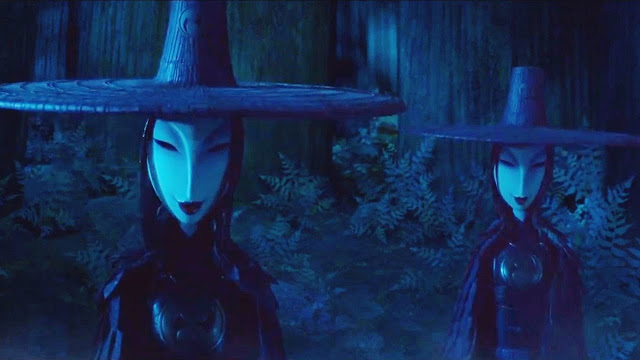The opening voiceover of Kubo and the Two Strings admonishes viewers not to blink. Closing our eyes, we are told, will result in the death of the film’s hero. It’s a bold gambit that could potentially induce groans from the audience, were it not accompanied by a ravishing image: a woman and her baby in a tiny canoe, surging forward against a giant wave, as rain lashes down and the moon shines ominously. It’s an enthralling sight, one that renders the narrator’s warning superfluous—who could possibly look away from such a scene? But that narration, beyond establishing the life-or-death stakes, speaks to the movie’s larger purpose. Kubo and the Two Strings isn’t just a story about an artist. It’s about how artists tell stories.
The artist-in-chief of Kubo is Travis Knight, the CEO of Laika, a studio that occupies a unique space in the American cinematic landscape. Eschewing the digital wizardry of Pixar and DreamWorks, Laika instead makes movies via stop-motion animation, that laborious method of physically manipulating individual objects for illusive effect. (This playful scene illustrates just how mind-bogglingly arduous the technique is.) Its first three films—Coraline, ParaNorman, and The Boxtrolls—married this painstaking approach to an off-kilter weirdness, resulting in distinctly original pictures that were always interesting, if not quite astonishing. But Kubo and the Two Strings, which is Knight’s directorial debut, is the studio’s best movie yet, combining the doting meticulousness of its prior works with a sweeping, stirring narrative and richly drawn characters. The style may be new-fangled, but the storytelling is old-fashioned in the best ways.
Following its gripping prologue, the movie opens in an isolated cave, where the pre-teen, one-eyed Kubo (Art Parkinson) lives with his invalid mother. Their dynamic appears to be inverted from the typical mother-son relationship, with Kubo carefully feeding her, grooming her, and comforting her when she suffers nightmares. (The feeding involves chopsticks, and while it’s never specified, the film clearly takes place in a historical Japan; predictably, protests have arisen regarding the racial composition of the cast, which is predominantly white, and exclusively so for the lead roles.) He also functions as the family breadwinner: By day, he ventures down to the vibrant village below their spartan home and goes to work.
Doing what, you might ask? Like all children in fantasy films, Kubo is unusually gifted, but he is not a warrior, a wizard, or an alien. He is instead an entertainer, and his weapon of choice is a shamisen, a three-stringed lute that looks like an elongated banjo. Whenever he plays this instrument, he is able to summon to life colored pieces of origami, including a burnt-orange samurai, an ice-blue tyrant, and—in a concession that he admits feeds the public’s appetite for comic relief—a huge yellow chicken that lays treacherous eggs. In the movie’s best scene, the townsfolk circle Kubo and his paper figurines, rapt with attention as he spins a yarn (originally told to him by his mother) of intrigue and deception, the origami reenacting every death-defying step of his tall tale. It’s a giddy sequence, but it also highlights Kubo’s sly talent as a raconteur; when he suddenly stops and leaves the crowd with a massive cliffhanger (“Come back tomorrow!”), he’s performing the same teasing dance that Charles Dickens once staged with his weekly serials.
What Kubo does not realize is that he is actually telling his own story. He learns the truth soon enough when, one fateful day, he disregards his mother’s warning not to stay outside after dark and finds himself confronted by spectral twin sisters (both voiced by Rooney Mara). They are in fact his aunts, servants of his grandfather (Ralph Fiennes), a ruthless assassin known as the Moon King who is responsible for Kubo’s missing eye and who craves to fully blind him, for reasons too elaborate to explain. They have been hunting him for a decade, and upon locating him, they waste no time attempting to kidnap him. Only through his mother’s desperate use of magic—and the sacrifice of her life—does Kubo escape, at which point he finds himself lost, orphaned, and afraid.
Whoa, that turned heavy in a hurry. But one of the pleasures of Kubo and the Two Strings is how it resists the temptation to coddle its young audience and how it instead, with impressive honesty, explores the darkness at its center. Fundamentally, this is a movie about loss, struggle, and grief. This is not to say that it is grim; on the contrary, with its second act it adroitly transforms into a streamlined quest narrative, at which point it attains renewed urgency and excitement. Kubo, in order to vanquish the Moon King, must locate three pieces of enchanted armor—an unbreakable sword, an impenetrable breastplate, and an invulnerable helm. Along the way, he picks up two companions: Monkey (Charlize Theron), a surly primate devoted to his protection, and Beetle (Matthew McConaughey), a cheery, oversized insect who has lost his memory but who believes that he once apprenticed as a samurai under Kubo’s father.
The three make quite the idiosyncratic trio, and curiously, Kubo and the Two Strings is at its weakest when mapping their camaraderie. Screenwriters Marc Haimes and Chris Butler are clearly skilled with world-building, but their dialogue feels a bit forced, as though they felt obligated to shoehorn in “witty banter” but couldn’t figure out how to make the words sing. Some of the putative comedy is lazy—scenes of Monkey and Beetle’s canned squabbles are the only time the film feels like it’s dumbing itself down for children.
But if the script is occasionally imperfect, that’s never true of Knight’s animation. Capitalizing completely on the potential of stop-motion, Kubo and the Two Strings has a beautiful, striking look, with a specificity suited to its Asian setting. Characters’ emotions are plain on their faces, while movements are remarkably fluid; the origami, especially, rustle through the frame with a windswept whoosh. (The 3-D is mostly unobtrusive, which calls into question the need for its existence.) Environments take on an anthropomorphic hue—somehow, the ocean currents look predatory (not to mention the malevolent eyeballs floating underneath), while the glinting moonlight, which personifies Kubo’s villainous grandfather, seems downright sinister. Perhaps the most enduring figures are those chilling twin sisters—costumed like wicked witches of the far east, they wear ghostly kabuki masks that narrow their eyes and hide their mouths, suggesting porcelain china dolls brought to terrifying life.
In addition to the movie’s visual splendor, Knight proves himself an able director of robust, coherent action. A sequence where Kubo, Monkey, and Beetle face off against a towering skeleton is good kinetic fun, while Monkey’s maritime battle against one of the sisters—the latter wielding a metallic whip without quarter—is a thrilling duel of speed and ferocity. Dario Marianelli’s vigorous, plucky score augments the intensity of these scenes while also surreptitiously deepening the pathos of the quieter moments.
Those gentler scenes are where the movie’s heart truly lies. Kubo‘s preoccupation with the ephemeral may explain its curious ending, which is not entirely satisfying but which, in defying easy gratification, is gratifying in its own way. (It is likely to be particularly poignant to those who have suffered significant loss.) But even in the context of its persistent sorrow, Kubo and the Two Strings is a joyous moviegoing experience, telling a wonderful fairy tale with zest and craft. In this, it is testament to the power of memory, of family, and, above all, of great stories.
Jeremy Beck is the editor-in-chief of MovieManifesto. He watches more movies and television than he probably should.




